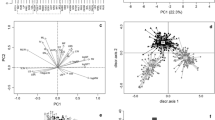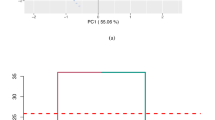Abstract
Editing of community data matrices is complementary to analyzing data by multivariate techniques of classification and ordination in the overall task of data analysis. A computer program, DATAEDIT, is described that can perform numerous editing functions, including data transformation, deletion of certain species or samples, deletion of rare species, deletion of outliers, separation of disjunet sample groups, reordering of the species or samples of a data matrix, and the formation of composite samples or of sample subsets. DATAEDIT can use the information in a nonhierarchical or hierarchical classification, and includes its own internal routine for reciprocal averaging ordination.
Similar content being viewed by others
References
Austin, M. P. & Belbin, L., 1980. The Application of the Twostop Algorithm to Two Floristie Data Sets. Inst. of Earth Resources, CSIRO, Canberra. 7 pp.
Austin, M. P. & Greig-Smith, P., 1968. The application of quantitative methods to vegetation survey. II. Some methodological probiems of data from rain forest. J. Ecol. 56: 827–844.
Bray, J. B. & Curtis, J. T., 1957. An ordination of the upland forest communlties of southern Wisconsin. Ecological Monographs 27: 325–349.
Gauch, H. G., 1977. GRDIFLEX a Flexible Computer Program of Four Ordination Techniques: Weighted Averages, Polar Ordination, Prineipal Components Analysis, and Reciprocal Averaging, Relcase B. Ecology and Systematics, Cornell University, Ithaca, New York 14853. 185 pp.
Gauch, H. G., 1979. COMPCLUS a FORTRAN Program for Rapid Initial Clustering of Large Data Sets. Ecology and Systematics, Cornell University, Ithaca, New York 14853. 59 pp.
Gauch, H. G., 1982. Multivariate Analysis in Community Ecology. Cambridge University Press, Cambridge.
Gauch, H. G., Whittaker, R. H. & Wentworth, T. R., 1977. A comparative study of reciprocal averaging and other ordination techniques. J. Ecol. 65: 157–174.
Goff, F. G., 1975. Comparison of species ordinations resulting from alternative indices of interspccific association and different numbers of included species. Vegetation 31: 1–14.
Green, R. H., 1980. Multivariate approaches in ecology the assessment of acologic similarity. Ann. Rev. Ecol. and Syst. 11: 1–14.
Hill, M. O., 1979a. DECORANA a FORTRAN Program for Detrerded Correspondence Analysis and Reciprocal Averaging. Ecology and Systematics, Cornell University, Ithaca, New York 14853, 52 pp.
Hill, M. O., 1979b. TWINSPAN a FORTRAN Program for Arranging Multivariate Data in án Ordered Two-way Table by Classification of the Individuals and Attributes. Ecology and Systematics, Cornell University, Ithaca. New York 14853, 90 pp.
Hill, M. O. & Gauch, H. G., 1980. Detrended correspondence analysis: an improved ordination technique. Vegetatio 42: 47–58.
Huntley, B., Huntley, J. P. & Birks, H. J. B., 1981. PHYVTOPAK a suite of computer programs designed for the handling and analysis of phytosociological data. Vegetatie 45: 85–95.
Maarel, E.van der, 1979. Transformation of cover-abundance values in phytosociology and its effects on community simllarity. Vegetatio 39: 97–114.
Noy-Meir, I., Walker, D., & Williams, W. T., 1975. Data transformations in ecological ordination. II. On the mesning of data standardization. J. Ecol. 63: 779–800.
Orlóci, L., 1978. Multivariate Analysis in Vegetation Research. Junk, The Hague.
Orlóci, L. & Makkattu, M. M., 1973. The effect of species number and type of data on the resemblance structure of a phytosociological collection. J. Ecol. 61: 37–46.
Peet, R. K., 1980. Ordination as a tool for analyzing complex data sets. Vegetatio 42: 171–174.
Singer, S. B. & Gauch, H. G., 1979. CONDENSE Convert Data Matrices from any ORDIFLEX Format into a Condensed Format by Samples. Ecology and Systematics. Cornell University, Ithaea, New York 14853. 7 pp.
Wildi, O., 1980. Management and multivariate analysis of large data sets in vegetation research. Vegetatio 42: 175–180.
Author information
Authors and Affiliations
Additional information
We appreciate valuable suggestions from the late Robert H. Whittaker, and from Philip Dixon, David Hieks, Laura Huenneke, Linda Olsvig-whittaker, and Mark Wilson. Mark O. Hill kindly supplied a fast subroutine for reciprocal averaging.
Rights and permissions
About this article
Cite this article
Gauch, H.G., Singer, S.B. A program for editing of community data matrices. Vegetatio 49, 187–190 (1982). https://doi.org/10.1007/BF00123843
Accepted:
Issue Date:
DOI: https://doi.org/10.1007/BF00123843




